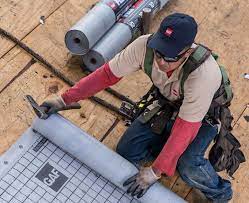Roofing Underlayment: The Foundation of a Solid Roof Installation
Most homeowners focus on the visible aspects of roofing, such as shingle color, style, and curb appeal. While these elements are unquestionably important in creating an appealing roof, there is one critical, but often overlooked, component that serves as the foundation of a solid roof installation: roofing underlayment. Consider roofing underlayment to be the unsung hero of your roof—it’s hidden beneath the shingles but plays an important role in keeping your roof durable, waterproof, and long-lasting. In this blog post, we’ll discuss the significance of roofing underlayment, the various types available, and why it’s an essential component of any roof installation.
Recognizing Roofing Underlayment
Roofing underlayment, also known as roof underlayment or felt paper, is a layer of material installed on the roof deck prior to the application of the primary roofing material (shingles, tiles, metal, etc.). It serves as a second layer of protection between the roof covering and the roof deck. While it may not be visible once the roofing is finished, the underlayment serves several important functions in protecting your home.
Roofing Underlayment’s Essential Functions:
1. Waterproofing: The primary function of roofing underlayment is to keep water out of the roof deck. Even if your shingles are damaged or compromised, the underlayment will keep your home dry.
2. Moisture Management: Roofing underlayment aids in the management of moisture within the roof structure. It allows the roof to breathe while preventing excessive moisture buildup, which can cause rot and decay.
3. Ice Dam Protection: In colder climates, roofing underlayment is critical for preventing ice dams. It adds another layer of protection against melting ice and snow that might otherwise seep into your attic or living spaces.
4. Insulation: Some types of underlayment provide additional insulation, increasing the energy efficiency of your home by reducing heat loss through the roof.
5. Protection During Installation: The underlayment protects the roof deck from potential damage caused by foot traffic, tools, or equipment while the roof is being installed.
Now that we’ve established why roofing underlayment is necessary, let’s look at the various types available and when each is most appropriate.
Roofing Underlayment Types
The type of roofing underlayment you choose is determined by several factors, including the local climate, the type of roof covering, and your budget. The following are the most common kinds of roofing underlayment:
1. Felt Paper with Asphalt Saturation
Asphalt-saturated felt, also known as “felt paper,” is one of the oldest and most common types of roofing underlayment. It is made from a base material that has been saturated with asphalt (typically cellulose or fiberglass).
Pros:
- Affordability: Felt paper is frequently the most affordable option for roofing underlayment.
- Water Resistance: It has good water resistance in most climates.
- Flexibility: Felt paper is somewhat flexible, which makes it easy to work with during installation.
Cons:
- Moisture Susceptibility: Felted paper can become susceptible to moisture over time.
- Tears and Wrinkles: During installation, it may tear or wrinkle, reducing its effectiveness.
- Less Durable: For extreme weather conditions, felt paper may not be the best choice.
2. Underlayment Synthetic
Synthetic underlayment is a more contemporary alternative to felt paper. It is constructed of synthetic materials such as polypropylene or polyester and is intended to be more durable and weather-resistant.
Pros:
- Superior Water Resistance: Synthetic underlayment is water resistant and durable.
- Lightweight: It is lightweight and easy to handle during installation.
- Mold and UV Ray Resistant: Synthetic underlayment is less prone to mold growth and UV damage.
- Extreme Weather Capability: It performs well in extreme weather conditions.
- Less Prone to Tears and Wrinkles: When installed, synthetic underlayment is less likely to tear or wrinkle.
Cons:
- Cost: It is usually more expensive than felt paper.
- Breathability: Some synthetic underlayments may be less breathable than other options.
3. Peel-and-Stick Rubberized Asphalt Underlayment
Rubberized asphalt underlayment, also known as “peel-and-stick” underlayment, is a self-adhesive material with high water resistance and durability. It is commonly used in areas prone to heavy rainfall or hurricanes.
Pros:
- Superior Water Resistance: The rubberized asphalt underlayment is extremely water resistant.
- Self-Adhesive: It is self-adhesive, making it simple to install and ensuring a secure seal.
- Highly Durable: This type of underlayment is well-known for its longevity and durability.
- Ideal for Extreme Weather: It is an excellent choice for areas prone to extreme weather.
Cons:
- Costlier: Rubberized asphalt underlayment is more expensive than traditional felt paper.
- Proper Installation: A watertight seal requires proper installation.
4. Ice and Water Protection
Ice and water shield is a high-quality roofing underlayment that is specifically designed to prevent ice dams and water infiltration. It is most commonly used in colder climates where snow and ice accumulation are a concern.
Pros:
- Superior Water Resistance: The ice and water shield provides superior water resistance.
- Self-Adhesive and Watertight: It adheres to itself and forms a watertight seal around fasteners.
- Ideal for Ice Dam Prevention: This underlayment is excellent at preventing ice dams.
- Added Insulation: It provides additional insulation, which improves energy efficiency.
Cons:
- Costlier than Other Underlayment Options: Ice and water shield is more expensive.
- Overkill in Mild Climates: It may be unnecessary in areas where there is no ice or snow.
The Value of Proper Installation
The right type of underlayment for your roofing project is critical, but so is its proper installation. Even the best underlayment materials can be ruined by improper installation. Here are some important factors to consider for a successful underlayment installation:
1. Clean and Smooth Roof Deck:
The roof deck should be clean, smooth, and free of debris before installing underlayment. To avoid damage to the underlayment, any protruding nails or sharp objects should be removed.
2. Overlap and Fastening:
Each roll or sheet of underlayment should overlap the one before it, as directed by the manufacturer. Proper fastening, such as the use of cap nails or staples, is critical to ensuring that the underlayment remains securely in place even in high winds.
3. Seal All Joints and Penetrations:
Use a compatible roofing sealant to seal all joints and penetrations, such as vents and chimneys. This keeps water from getting under the underlayment.
4. Flashing Integration:
Ensure that the underlayment is properly integrated with flashing materials around roof edges, valleys, and other critical areas. Flashing directs water away from vulnerable roof areas.
5. Professional Installation:
Consider hiring a professional roofing contractor such as Pinnacle Exteriors who has experience installing underlayment. They have the knowledge to ensure that the underlayment is installed correctly and provides the intended protection.
When Should Roofing Underlayment Be Replaced?
Roofing underlayment is a temporary component of your roof that may need to be replaced over time. The lifespan of underlayment can vary depending on the material used, local climate conditions, and the initial installation quality. Here are a few indicators that it’s time to replace your roofing underlayment:
1. Visible Damage: If the underlayment has tears, punctures, or visible signs of wear and tear, it should be replaced to maintain its effectiveness.
2. Roof Leaks or Water Damage: If you have roof leaks or water damage in your home, this could indicate that the underlayment has become compromised and needs to be replaced.
3. Roof Replacement: When replacing your roof covering (shingles or other materials), it’s a good idea to also replace the underlayment, particularly if it’s old or damaged.
4. Roofing Inspection: A professional may recommend replacing the underlayment during a routine roofing inspection if it is no longer providing adequate protection.
To Summarize
Roofing underlayment may not be the most visually appealing aspect of your roof, but it is critical in protecting your home from water damage, moisture issues, and ice dams. Selecting the appropriate underlayment for your climate and roofing materials, as well as proper installation, is critical for a long-lasting and resilient roof. If you are planning a roof installation or suspect that your current underlayment needs to be replaced, consult with a professional roofing contractor to ensure that your roof receives the solid foundation it requires. Remember that a properly protected roof is critical to keeping your home safe, comfortable, and dry for many years to come, learn more about Pinnacle Exteriors.







